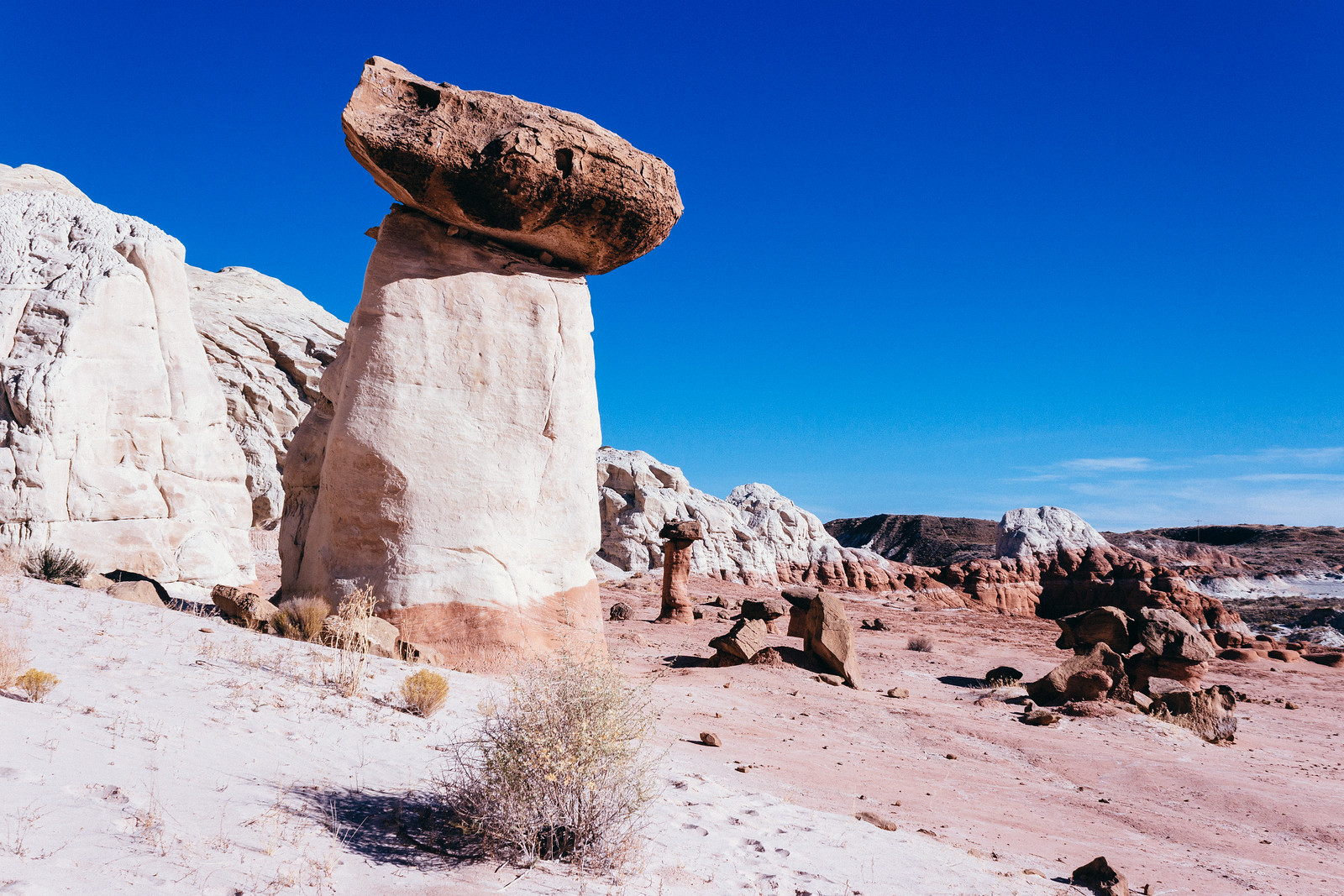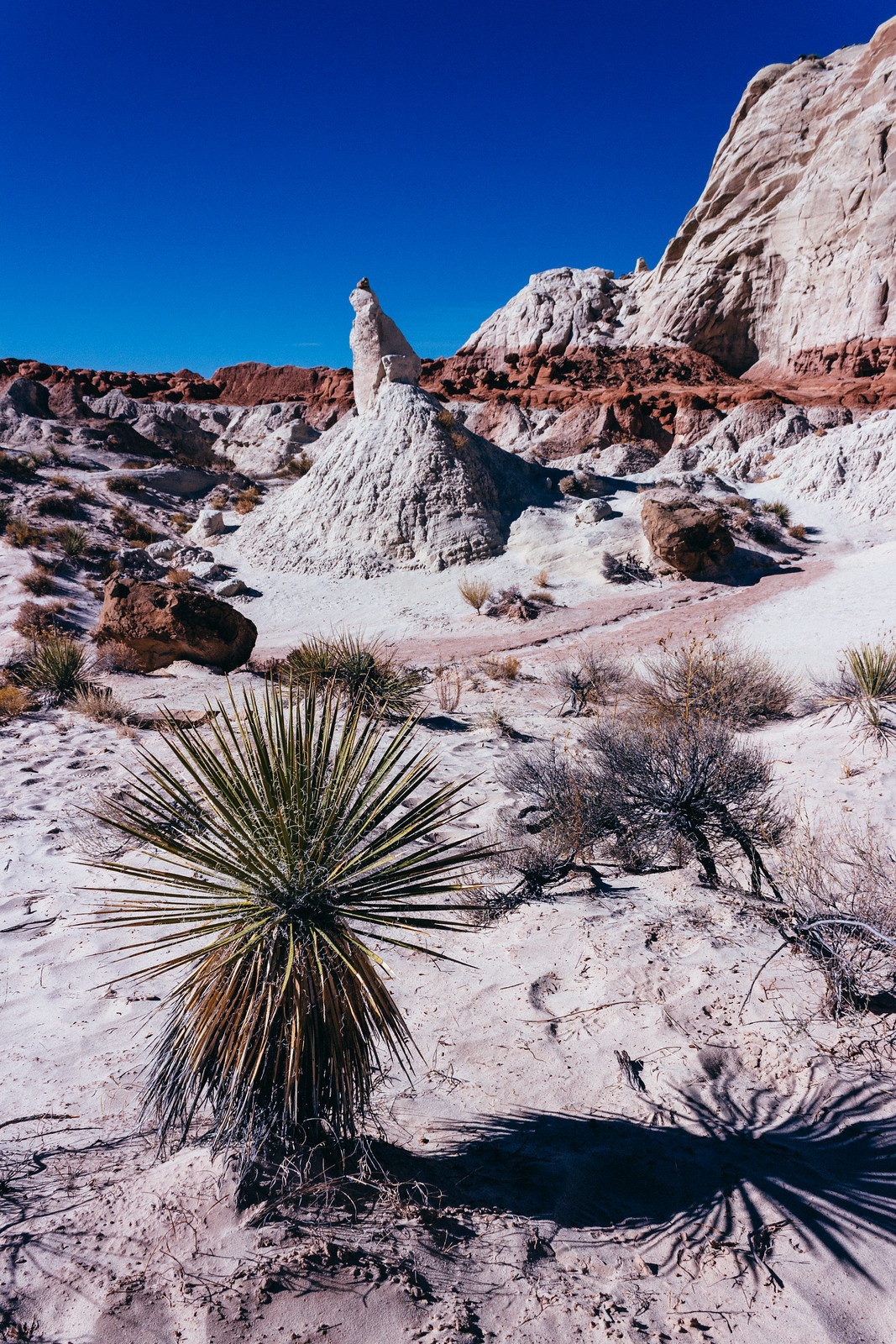Hiking to Utah’s Toadstool Hoodoos in Grand Staircase-Escalante National Monument
An impromptu weekend roadtrip last fall took me from Phoenix north to the Arizona-Utah border, where I split my time between Kanab, Utah, and Page, Arizona. U.S. Highway 89 runs between Kanab and Page—two of the most isolated towns in the country—passing through some of the most desolate, stunning scenery on the way.
U.S. 89 also skirts the southern edge of Grand Staircase-Escalante National Monument, a national park that basically acts as a preserve of all the federally-owned land between Bryce Canyon National Park and Glen Canyon National Recreation Area. A roadside pull-off led me right inside the park boundaries to the Toadstool Hoodoos, otherworldly formations eroded from the rock by wind, rain, and snow.
Because the park spans so much of far-southern Utah, it’s difficult to grasp what exactly it contains. Most folks typically split it up into wedge-shaped thirds. The western section encompasses the Grand Staircase, a vast domain of successive plateaus that abruptly end in white, red, or brown cliffs, giving way to one geological layer after another in a south-to-north stairstep fashion: a staircase on the scale of the gods.
Sandwiched in the middle rises the Kaiparowits Plateau, a rugged landscape that silently guards fossils—and fossil fuels. Although it’s the perfect destination for those keen on desolate backcountry adventures, the plateau has somewhere around nine billion tons of coal deposits, putting it at the epicenter of the American West’s decades-old fight between resource extraction and natural conservation. The Toadstool Hoodoos balance precariously at the foothills of the Kaiparowits, their future uncertain in a monument whose boundaries were drastically reduced by the Trump administration.
To the east flows the Escalante River and its tributaries. This is slot canyon country, where backpackers whisper the names of claustrophobia-inducing narrows like “Spooky Gulch” and “Peek-a-Boo Canyon.” Perhaps one day I’ll have enough courage to risk death-by-flash-flood and squeeze between the vermilion walls of these slot canyons, but for now, I’m content with day hikes to see hoodoos.
So what are hoodoos, exactly? Also called “goblins” and “ghosts,” hoodoos are the last, lonely remnants of entire rock layers that have been reduced to Dr. Seuss-like totem poles and smooth, organic shapes. As the elements relentlessly work away at cliff faces, they erode them into protruding fins before chipping away at windows and arches until ultimately freestanding hoodoos are left.
Often hoodoos will span multiple strata of earth, so when an upper rock layer is more durable than the softer stuff beneath it, a hoodoo may form with a comical mushroom cap on top.
Ultimately I found the striking landscape at the feet of the Kaiparowits Plateau more interesting than the hoodoos themselves. The trail to the hoodoos begins in a low valley between multicolored hills of red, white, orange, gray, and brown stripes—an earthy rainbow of dust and rust. Short sea anemone-like stands of cyanobacteria bind the fragile dirt of the Colorado Plateau together into a cryptobiotic soil crust, visible on either side of the trail. Further in, the land turns a Moon-like pale gray, rolling and twisting until it crests at a small hill upon which rise the famous toadstools.
To the north of most of the “action” I found a rounded-out grotto carved into the cliffside by the same forces that shaped the hoodoos. Give this grotto a few thousand, or hundred thousand, years, and it, too, will break off into the seeds of future hoodoos. This quiet alcove served as the perfect setting for a post-hike lunch: shade from the sun and silence for reflection and rest.
The easy, 20-minute hike to the platform where these hoodoos pop up like mushrooms after the rain was a great appetizer of Grand Staircase-Escalante National Monument, in addition to being an ideal pitstop between the tourism hubs of Kanab, Utah, and Page, Arizona.
What’s next on my hoodoo list? The next time I’m in the area, I’d love to check out the Wahweap Hoodoos, just a few more miles down the road…but an adventure worth a full day’s hike.
The trailhead for the Toadstool Hoodoos is located 45 miles east of Kanab, Utah, off U.S. Highway 89, just past mile marker 20 on the north side of the highway. Parking and admission is free. Make sure to bring plenty of water, sunscreen, and a hat, as there is no shade on this trail. You’ll reach the hoodoos about one mile upstream along the dry wash—you can’t miss them.
U.S. 89 also skirts the southern edge of Grand Staircase-Escalante National Monument, a national park that basically acts as a preserve of all the federally-owned land between Bryce Canyon National Park and Glen Canyon National Recreation Area. A roadside pull-off led me right inside the park boundaries to the Toadstool Hoodoos, otherworldly formations eroded from the rock by wind, rain, and snow.
 |
| The hoodoo |
Because the park spans so much of far-southern Utah, it’s difficult to grasp what exactly it contains. Most folks typically split it up into wedge-shaped thirds. The western section encompasses the Grand Staircase, a vast domain of successive plateaus that abruptly end in white, red, or brown cliffs, giving way to one geological layer after another in a south-to-north stairstep fashion: a staircase on the scale of the gods.
Sandwiched in the middle rises the Kaiparowits Plateau, a rugged landscape that silently guards fossils—and fossil fuels. Although it’s the perfect destination for those keen on desolate backcountry adventures, the plateau has somewhere around nine billion tons of coal deposits, putting it at the epicenter of the American West’s decades-old fight between resource extraction and natural conservation. The Toadstool Hoodoos balance precariously at the foothills of the Kaiparowits, their future uncertain in a monument whose boundaries were drastically reduced by the Trump administration.
To the east flows the Escalante River and its tributaries. This is slot canyon country, where backpackers whisper the names of claustrophobia-inducing narrows like “Spooky Gulch” and “Peek-a-Boo Canyon.” Perhaps one day I’ll have enough courage to risk death-by-flash-flood and squeeze between the vermilion walls of these slot canyons, but for now, I’m content with day hikes to see hoodoos.
 |
| More hoodoos |
So what are hoodoos, exactly? Also called “goblins” and “ghosts,” hoodoos are the last, lonely remnants of entire rock layers that have been reduced to Dr. Seuss-like totem poles and smooth, organic shapes. As the elements relentlessly work away at cliff faces, they erode them into protruding fins before chipping away at windows and arches until ultimately freestanding hoodoos are left.
Often hoodoos will span multiple strata of earth, so when an upper rock layer is more durable than the softer stuff beneath it, a hoodoo may form with a comical mushroom cap on top.
 |
| Stark-white contrasts with orange layers |
Ultimately I found the striking landscape at the feet of the Kaiparowits Plateau more interesting than the hoodoos themselves. The trail to the hoodoos begins in a low valley between multicolored hills of red, white, orange, gray, and brown stripes—an earthy rainbow of dust and rust. Short sea anemone-like stands of cyanobacteria bind the fragile dirt of the Colorado Plateau together into a cryptobiotic soil crust, visible on either side of the trail. Further in, the land turns a Moon-like pale gray, rolling and twisting until it crests at a small hill upon which rise the famous toadstools.
 |
| The grotto |
To the north of most of the “action” I found a rounded-out grotto carved into the cliffside by the same forces that shaped the hoodoos. Give this grotto a few thousand, or hundred thousand, years, and it, too, will break off into the seeds of future hoodoos. This quiet alcove served as the perfect setting for a post-hike lunch: shade from the sun and silence for reflection and rest.
 |
| Badlands |
The easy, 20-minute hike to the platform where these hoodoos pop up like mushrooms after the rain was a great appetizer of Grand Staircase-Escalante National Monument, in addition to being an ideal pitstop between the tourism hubs of Kanab, Utah, and Page, Arizona.
What’s next on my hoodoo list? The next time I’m in the area, I’d love to check out the Wahweap Hoodoos, just a few more miles down the road…but an adventure worth a full day’s hike.
How to get there
 |
| Post at the parking lot |
The trailhead for the Toadstool Hoodoos is located 45 miles east of Kanab, Utah, off U.S. Highway 89, just past mile marker 20 on the north side of the highway. Parking and admission is free. Make sure to bring plenty of water, sunscreen, and a hat, as there is no shade on this trail. You’ll reach the hoodoos about one mile upstream along the dry wash—you can’t miss them.